Michelson Interferometer Educational Kit

- Designed for Education, Demonstration, and Classroom Use
- Easy-to-Use Kits Include Components Plus Free Educational Materials

Please Wait
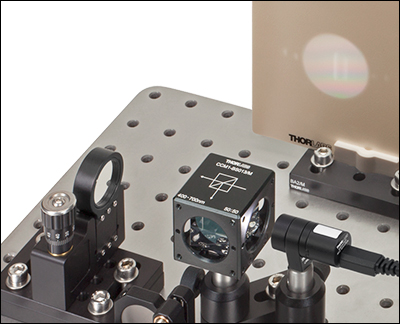
Click to Enlarge
Figure 1.1 White Light Interference Generated with the Michelson Interferometer Educational Kit
Michelson Interferometer Educational Kit
- Designed for Educational, Demonstration, and Classroom Use
- Complete Photonics Kit Includes All Hardware Except Variable Power Supply for the Thermal Expansion Experiment (12 VDC, 2 A)
- Extensive Manual and Teaching Materials Provided
- Easy to Assemble and Use
- Choose from Educational Kits Containing Imperial or Metric Components
Experiment
- Build and Examine the Properties of a Michelson Interferometer
- Examine the Second Output of the Interferometer
- Use the Interferometer as a Sensitive Spectrometer
- Generate White Light Interference
- Learn how the Interference Pattern is Affected by the Coherence Length of the Source
- Use the Interferometer to Measure the Physical Properties of Materials
- Refractive Index of Plexiglas® Plates
- Thermal Expansion Coefficient of an Aluminum Rod
Thorlabs' Michelson Interferometer Demonstration Kit highlights several ways that an interferometer can be used to take highly sensitive measurements. A laser and LEDs allow students to explore the concept of interference and examine how the coherence length of different light sources will affect the interferometer output. The interferometer can be aligned to produce white light interference using the included white LED, as shown in Figure 1.1. Students can also use the lab setup to determine the refractive index of Plexiglas plates and the thermal expansion coefficient of an aluminum rod.
Thorlabs Educational Products
Thorlabs' line of educational products aims to promote physics, optics, and photonics by covering many classic experiments, as well as emerging fields of research. Each educational kit includes all the necessary components and a manual that contains both detailed setup instructions and extensive teaching materials. These lab kits are being offered at the price of the included components, with the educational materials offered for free. Technical support from our educational team is available both before and after purchase.
Purchasing Note: Each educational kit contains both the English and German language versions of the manual, as well as US-, UK-, European-, and Chinese-style power cords. The power supplies and other electronic devices in both the metric and the imperial kit accept voltages of 230 VAC and 120 VAC. Some power supplies include a switch for selecting the mains voltage. See the respective manuals for details. Please contact Tech Support if you need a different cord style or power supply. The educational kits can be made portable using the CPS1 5 VDC Battery Pack (sold separately) to power the laser diode module or LEDs. As with all products on our website, taxes are not included in the price shown below.

Thorlabs' Michelson Interferometer Kit allows students to build a basic Michelson Interferometer and use their system to measure physical properties of a laser source and several materials. The kit includes all of the components needed to create a functioning interferometer including light sources, mirrors, a beamsplitter cube, and screen. The manual (available on our website and included with each kit) includes an explanation of the underlying theory behind each experiment as well as detailed instructions. A summary of the experiments supported by the kit is provided below.
Michelson Interferometer
Students begin by building and aligning the interferometer so that they can observe the interference generated by the path length difference in the interferometer arms. The basic setup consists of a green laser source on a kinematic mount, a beamsplitter, one mirror mounted on a translation stage, a second mirror in a kinematic mount on a fixed post, and a screen, as shown in the schematic in Figure 2.1.
A common misconception among students is that light from the system is lost when destructive interference is observed on the viewing screen. To address this, an additional beamsplitter plate is included to allow students to observe the second output of the interferometer, i.e., the light that travels back towards the laser output, as shown in Figure 2.2. Students can see that when a bright spot is observed at the center of the interference pattern from the primary interferometer output, the secondary interferometer output has a dark spot at the center (see Figure 2.3). The light is simply re-distributed, not lost from the system.
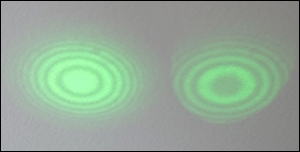
Click to Enlarge
Figure 2.3 A closeup of both interferometer outputs, as they appear on the screen in Figure 2.2. The output that propagates towards the laser is on the right, while the output that propagates perpendicular to the input laser is on the left.

Click to Enlarge
Figure 2.2 The kit includes a second beamsplitter that allows students to observe the output of the interferometer in the direction of the laser and compare it to the main output of the interferometer.
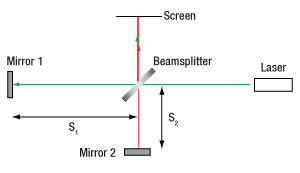
Click to Enlarge
Figure 2.1 A Schematic of the Beam Path in a Basic Michelson Interferometer
Wavelength Measurement and Using the Interferometer as a Spectrometer
The kit guides students through an experiment that allows them to determine the wavelength of the included laser source, and then measure the wavelength difference between two spectral peaks in the laser's emission profile. To perform the first experiment, students count the number of light-dark-light transitions that occur as the mirror is moved a specified distance using a translation mount with a micrometer drive. Then, the wavelength can be calculated using the equation:

where Δx is the distance that the mirror is moved, N is the number of transitions, and λ is the wavelength of the laser.
Next, students can use the interferometer to determine the wavelength split of the peaks of the laser emission profile. Since the laser emits simultaneously at several different wavelengths, each wavelength will produce its own interference pattern. At certain path length differences between the interferometer arms, the interference patterns from two wavelength peaks will overlap perfectly and be visible with good contrast between the dark and light fringes. At certain distances, however, the bright fringes of one interference pattern will overlap with the dark fringes of the other interference pattern, producing a pattern with poor contrast. By measuring the change in path length difference as the contrast shifts from poor, to good, and back to poor, students can calculate the wavelength difference between the two peaks in the laser's emission spectrum.
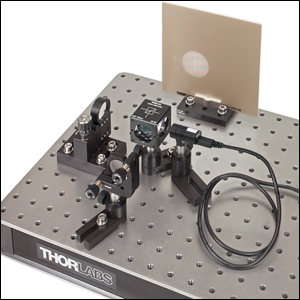
Click to Enlarge
Figure 2.4 The kit includes a white light LED that can be used to observe white light interference, allowing students to explore the concept of coherence length.
Coherence Length and White Light Interference
A Michelson Interferometer provides an intuitive way to explore the concept of coherence length: in this context, the coherence length of a source corresponds to the maximum difference in path length between the interferometer arms that still allows interference to be observed. In this kit, students can use their setup to measure the coherence length of red and white LEDs, using the setup shown in Figure 2.4. After installing an LED in the interferometer, students adjust the position of one mirror until the interference pattern is close to disappearing. The coherence length should be approximately twice the difference in path length between the two interferometer arms. In order to compare their results with theory, students can then calculate an estimated coherence length from the wavelength and bandwidth of the source using the following equation:

where ΔLc is the coherence length, λ0 is the center wavelength, and Δλ is the bandwidth.
After aligning their setup using the laser and red LED, students can place the included white LED in the setup to generate white light interference.

Click to Enlarge
Figure 2.5 Rotating a Plexiglas plate in one interferometer arm allows the refractive index to be measured.
Determining the Refractive Index of a Material
The kit includes two Plexiglas® plates, 8 mm and 12 mm thick, so that students can use the interferometer to measure the refractive index of this material. A Plexiglas plate is placed into one of the interferometer arms perpendicular to the beam path (see Figure 2.5). Since the plate has a different index of refraction than the surrounding air, light passing through the interferometer arm with the plate will see a different effective optical path length than light in the other interferometer arm. If the plate is rotated, the thickness of the material in the beam path increases; as a result, the optical path length experienced by light traveling along that arm of the interferometer also changes. The change in optical path length can be determined by counting the number of light-dark-light transitions in the center of the interference pattern as the plate is rotated through a given angle. The refractive index, n, of the material can be calculated using the following equation:

where N is the number of light-dark-light transitions, λ is the wavelength of the laser light, t is the thickness of the Plexiglas plate, and α is the rotation angle of the plate. A detailed description of how to derive this equation based on the interferometer geometry is provided for students in the manual.

Click to Enlarge
Figure 2.6 One mirror of the interferometer is mounted on the end of an aluminum rod that is wrapped in a heater. The rod temperature is monitored, allowing the coefficient of thermal expansion to be calculated using the temperature change and total number of fringes that move out of the center of the interference pattern as the rod expands.
Measuring the Coefficient of Thermal Expansion
The final experiment enabled by the kit allows the thermal expansion coefficient of an aluminum rod to be measured using the kit. The rod is wrapped in a foil heater and mounted with a mirror attached to one end, as shown in Figure 2.6.* This assembly takes the place of the mirror at the end of one of the interferometer arms, and the setup is aligned so that interference is visible. A temperature sensor is inserted into the back end of the aluminum rod, allowing the rod temperature to be recorded. The resistive heater is connected to a voltage source, heating the rod and causing it to expand; this, in turn, causes the mirror position to shift. Students count the number of dark-light transitions that occur at the center of the interference pattern during this process, which corresponds to the change in the optical path length caused by the expansion of the rod due to heating. The coefficient of thermal expansion, α, can be calculated from the number of light-dark-light transitions and temperature change as follows:

where N is the number of light-dark-light transitions, λ is the wavelength of the light source, L0 is the original length of the rod, and ΔT is the temperature change.
*The necessary variable power supply to drive the heater is not provided in the kit.
Michelson Interferometer Educational Kit Components
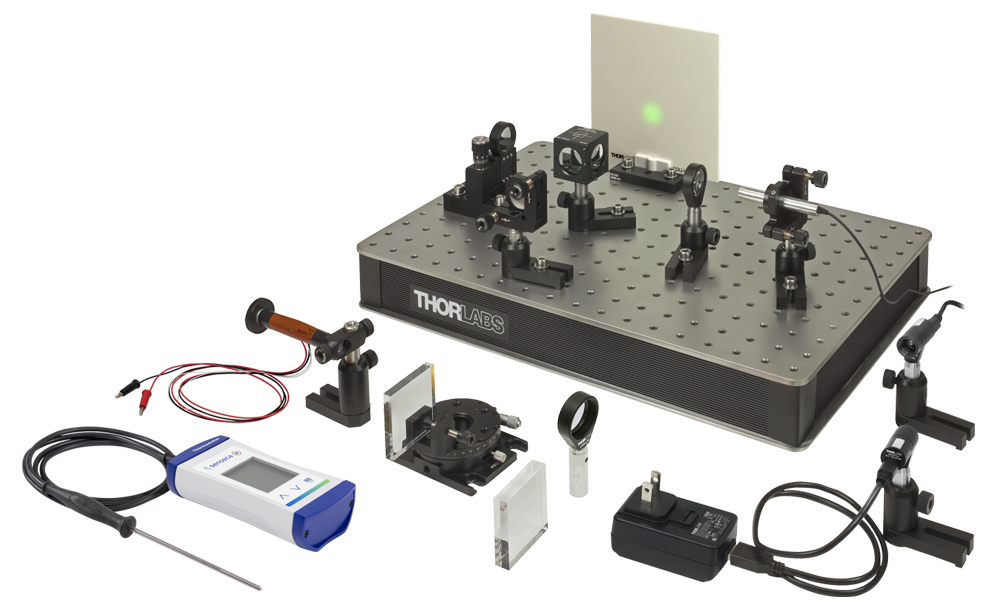
Thorlabs' Michelson Interferometer Educational Kit is available in imperial and metric versions. In cases where the metric and imperial kits contain parts with different item numbers, metric measurements are indicated by parentheses unless otherwise noted.
| Description | EDU-MINT2 Item # |
EDU-MINT2/M Item # |
Qty. |
|---|---|---|---|
| Basic Interferometer Components | |||
| Steel Breadboard, 12" x 18" (30 cm x 45 cm) | B1218FX | B3045AX | 1 |
| Rubber Damping Feet, Set of 4 | RDF1 | 1 | |
| Collimated Laser Diode Module, 532 nm, Class II |
CPS532-C2 | 1 | |
| 5 VDC Regulated Power Supply with USB Type-A Port | DS5a | 1 | |
| USB 2.0 Type-A to 2.5 mm Phono Cable, 1.78 m Long | CPSA | 1 | |
| Ø1" Unthreaded Adapter for Ø11 mm Components |
AD11NT | 1 | |
| Ø1" Kinematic Mirror Mount | KM100 | 2 | |
| Ø1" Protected Silver Mirror | PF10-03-P01 | 2 | |
| Z-Axis Translation Mount | SM1ZP | SM1ZP/M | 1 |
| Height Spacer, 2" x 3" x 0.25" (50 mm x 75 mm x 6.25 mm) |
BA2S5 | BA2S5/M | 1 |
| Base, 2" x 3" x 3/8" (50 mm x 75 mm x 10 mm) | BA2 | BA2/M | 2 |
| Plastic Viewing Screen | EDU-VS1 | EDU-VS1/M | 1 |
| Ø1" Lens Mount | LMR1 | LMR1/M | 1 |
| Ø1" N-BK7 Bi-Convex Lens, f = 50.0 mm | LB1471 | 1 | |
| Non-Polarizing Beamsplitter Cube, 400 - 700 nm |
CCM1-BS013 | CCM1-BS013/M | 1 |
| 1.5" (30 mm) Long Universal Post Holder | UPH1.5 | UPH30/M | 4 |
| Ø1/2" Post, 1.5" Long | TR1.5 | N/Ab | 4 |
| Ø12.7 mm Post, 30 mm Long | N/Ac | TR30/M | 2 |
| Ø12.7 mm Post, 40 mm Long | N/Ac | TR40/M | 2 |
| Components to Observe 2nd Interferometer Output | |||
| Ø1" Economy Beamsplitter | EBS1 | 1 | |
| Ø1" Lens Mount | LMR1 | LMR1/M | 1 |
| Ø1/2" (Ø12.7 mm) Post, 1.5" (40 mm) Long | TR1.5 | TR40/M | 1 |
| Description | EDU-MINT2 Item # |
EDU-MINT2/M Item # |
Qty. |
|---|---|---|---|
| Refractive Index Measurement | |||
| High-Precision Rotation Mount | PR01 | PR01/M | 1 |
| General Purpose Plate Holder | FP01 | 1 | |
| Plexiglas Plate, 8 mm Thick | - | 1 | |
| Plexiglas Plate, 12 mm Thick | - | 1 | |
| Interference with LEDs | |||
| 639 nm LED, 7.2 mW (Pack of 5) | LED630E | 1 | |
| White Light LED, 15 mW (Pack of 5) | LEDW7E | 1 | |
| LED Mount | LEDMT1F | 2 | |
| 1.5" (40 mm) Long Universal Post Holder | UPH1.5 | UPH40/M | 1 |
| Ø1/2" (Ø12.7 mm) Post, 1.5" (40 mm) Long | TR1.5 | TR40/M | 2 |
| Ø1/2" Lens Mount with SM05 Internal Threads | SMR05 | SMR05/M | 2 |
| SM05 Lens Tube, 0.30" Thread Depth | SM05L03 | 2 | |
| 5 VDC USB Power Supply | DS5a | 1 | |
| 72" USB 2.0 Type-A Extension Cable | USB-C-72 | 1 | |
| Ruler, 12" (30 cm) | - | 1 | |
| Thermal Expansion Setup | |||
| Mirror Holder for Ø1" Optics | MH25 | 1 | |
| Ø1" Aluminum Mirror | ME1-G01 | 1 | |
| Aluminum Post, Ø12.7 mm x 90 mm Long | - | 1 | |
| Right-Angle Post Clamp | RA90 | RA90/M | 1 |
| Ø1/2" (Ø12.7 mm) Post, 2" (50 mm) Long | TR2 | TR50/M | 1 |
| 1.5" (40 mm) Long Post Holder | PH1.5 | PH40/M | 1 |
| Base, 1" x 2.3" x 3/8" (25 mm x 58 mm x 10 mm) |
BA1S | BA1S/M | 1 |
| Digital Thermometer | - | 1 | |
| Foil Heater with 10 kΩ Thermistor and Banana Plugs | HT10Kb | 1 | |
| Electrical Tape | - | 1 | |
Imperial Kit: Included Hardware and Screws
| Description | Item # | Qty. |
|---|---|---|
| 3/16" Balldriver for 1/4"-20 Cap Screwsa | BD-3/16L | 1 |
| 5/64" Hex Keya | - | 1 |
| 7/64" Hex Keya | - | 1 |
| 1/16" Hex Keya | - | 1 |
| 9/64" Hex Keya | - | 1 |
| 1/4"-20 Cap Screw, 1/4" Long | SH25S025b | 2 |
| 1/4"-20 Cap Screw, 3/8" Long | SH25S038b | 1 |
| 1/4"-20 Cap Screw, 1/2" Long | SH25S050b | 4 |
| 1/4"-20 Cap Screw, 5/8" Long | SH25S063b | 9 |
| 1/4"-20 Cap Screw, 3/4" Long | SH25S075b | 4 |
| 6-32 Cap Screw, 1/4" Long | - | 1 |
| 8-32 Cap Screw, 3/8" Long | SH8S038c | 1 |
| 8-32 Cap Screw, 5/8" Long | - | 3 |
| 1/4" Washer | W25S050d | 15 |
| 1/4" Counterbore Adapter Ring for #8 Screws | SD1e | 4 |
Metric Kit: Included Hardware and Screws
| Description | Item # | Qty. |
|---|---|---|
| 5 mm Balldriver for M6 Cap Screwsa | BD-5ML | 1 |
| 1.5 mm Hex Keya | - | 1 |
| 2 mm Hex Keya | - | 1 |
| 3 mm Hex Keya | - | 1 |
| M6 Cap Screw, 8 mm Long | - | 2 |
| M6 Cap Screw, 10 mm Long | SH6MS10b | 1 |
| M6 Cap Screw, 12 mm Long | SH6MS12b | 4 |
| M6 Cap Screw, 16 mm Long | SH6MS16b | 9 |
| M6 Cap Screw, 20 mm Long | SH6MS20b | 4 |
| M4 Cap Screw, 6 mm Long | SH4MS06c | 1 |
| M4 Cap Screw, 10 mm Long | SH4MS10c | 1 |
| M4 Cap Screw, 16 mm Long | SH4MS16c | 3 |
| M6 Washer | W25S050d | 15 |
| M6 Counterbore Adapter Ring for M4 Screws | SD1e | 4 |
Gravitational Wave Detection with Michelson Interferometers
A recent application of the Michelson interferometer that attracted a lot of international attention is gravitational-wave detection. Gravitational waves are oscillations in spacetime curvature produced by colliding black holes, neutron stars, and other astrophysical processes that involve a dense concentration of mass-energy moving at relativistic speeds. A network of laser interferometers has been constructed in several countries to detect these waves. This includes the Laser Interferometer Gravitational-Wave Observatory (LIGO) in the United States, VIRGO in Italy, GEO600 in Germany, and KAGRA in Japan. All of these experiments consist of a Michelson interferometer with kilometer-scale arm lengths. The mirrors are suspended and free to swing in the plane of the interferometer. A passing gravitational wave will shrink the mirror-beamsplitter distance in one arm of the interferometer while stretching that distance in the other arm. The oscillating shrinking/stretching pattern induced by the passing wave is recorded as an oscillating signal in the photodetector.

Click to Enlarge
Figure 4.1 Loud music with a strong bass line causes fluctuations in the interference pattern.
On September 14, 2015 the twin LIGO detectors (in Washington state and Louisiana) made the first direct detection of a gravitational wave. The signal (which was measured with high confidence in both detectors) was produced by an orbiting pair of black holes that merged together about a billion light years away. This signal caused the LIGO mirrors to move by about 10-18 meters, or nearly one-thousandth the diameter of a proton. Michelson interferometers can thus perform some of the most sensitive length measurements possible. LIGO and its partner observatories are vastly more complicated than the interferometer in this kit, but the fundamental physical principle behind their operation is Michelson interferometry.
Once the Michelson interferometer is assembled, it can be used as a simple classroom demonstration of the operating principles behind gravitational-wave detectors like LIGO, Virgo, and GEO600. In those kilometer-scale interferometers the mirrors are free to swing in the plane of the interferometer in response to passing gravitational waves. Those waves shrink one arm of the interferometer while stretching the other. In our kit interferometer, the mirrors do not swing, but the effect of a gravitational wave can be mimicked by a local vibration of the table top or an acoustic source. This will change the relative length between the two arms, resulting in an oscillation of the fringe pattern and a change in brightness of the central maximum.
More information about LIGO and the detection of gravitational waves can be found here:
LIGO Scientific Collaboration Homepage
LIGO Laboratory Homepage
Advanced LIGO Project Homepage
We cordially thank the LIGO collaboration, in particular Marc Favata, Nancy Aggarwal, and Maggie Tse, for this addition to the webpage.
Interferometer Demonstration Kit Comparison
Thorlabs offers three demonstration kits that make use of an interferometry setup. Each kit is designed to target a different topic and includes accessories to support the experiments described in the kit manual. The EDU-MINT2 interferometer kit is designed to explore the experimental uses of a Michelson Interferometer, while the EDU-BT1 and EDU-QE1 analogy demonstrations are designed to explore concepts in quantum mechanics. Due to the nature of the experiments in the EDU-MINT2 kit, an intrinsically damped breadboard is included to minimize vibrations as students interact with the setup. This added feature supports some of the more challenging experiments, especially the wavelength measurement and white light interference exercises. The other two demonstration kits are built on lighter, aluminum breadboards as the experiments outlined in these kits require less interaction with the setups and vibration is therefore less of an issue. Table 5.1 outlines the key features and educational topics addressed by each kit to aid in choosing the best option for your classroom.
| Table 5.1 Key Features | |||
|---|---|---|---|
| Interferometer Type | Michelson | Mach-Zehnder | |
| Kit Item # | EDU-MINT2(/M) | EDU-BT1(/M) | EDU-QE1(/M) |
| Description | Michelson Interferometer Demonstration Kit | "Bomb Tester" Demonstration Kit | Quantum Eraser Demonstration Kit |
| Kit Photo (Click to Enlarge) |
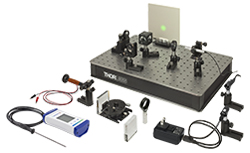 |
 |
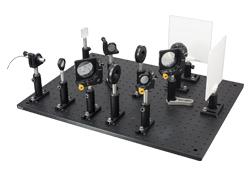 |
| Underlying Concept | Use a Michelson Interferometer as a Sensitive Instrument for Measuring Physical Properties |
Explore the "Bomb Tester" Thought Experiment with an Analogy Demonstration |
Explore the Dual Particle/Wave Nature of Light with an Analogy Demonstration |
| Light Sources | Laser (Class 2), Red LED, White LED | Laser (Class 2) | Laser (Class 2) |
| Breadboard | Steel Breadboard, 12" x 18" (30 cm x 45 cm) with Intrinsic Damping to Decrease the Effect of Vibrations |
Aluminum Breadboard, 12" x 12" (30 cm x 30 cm) | Aluminum Breadboard, 18" x 24" (45 cm x 60 cm) |
| Other Accessories |
Additional Beamsplitter to Observe Second Interferometer Output Plexiglas® Plates and Rotation Mount for Refractive Index Measurements Aluminum Rod, Heater, and Thermometer for Thermal Expansion Coefficient Measurement |
Detector for Measuring the Probability of Different States in the Analogy Experiment |
Polarizers to Observe the Effect of Polarization on the Interference Pattern |
| Educational Aspects |
|
|
|
Kit Conversion
Converting the EDU-MINT2(/M) kit to enable the demonstrations outlined in the EDU-BT1(/M) manual is simple; only a photodetector and the necessary mounting hardware are needed.
Laser Safety and Classification
Safe practices and proper usage of safety equipment should be taken into consideration when operating lasers. The eye is susceptible to injury, even from very low levels of laser light. Thorlabs offers a range of laser safety accessories that can be used to reduce the risk of accidents or injuries. Laser emission in the visible and near infrared spectral ranges has the greatest potential for retinal injury, as the cornea and lens are transparent to those wavelengths, and the lens can focus the laser energy onto the retina.
Safe Practices and Light Safety Accessories
- Laser safety eyewear must be worn whenever working with Class 3 or 4 lasers.
- Regardless of laser class, Thorlabs recommends the use of laser safety eyewear whenever working with laser beams with non-negligible powers, since metallic tools such as screwdrivers can accidentally redirect a beam.
- Laser goggles designed for specific wavelengths should be clearly available near laser setups to protect the wearer from unintentional laser reflections.
- Goggles are marked with the wavelength range over which protection is afforded and the minimum optical density within that range.
- Laser Safety Curtains and Laser Safety Fabric shield other parts of the lab from high energy lasers.
- Blackout Materials can prevent direct or reflected light from leaving the experimental setup area.
- Thorlabs' Enclosure Systems can be used to contain optical setups to isolate or minimize laser hazards.
- A fiber-pigtailed laser should always be turned off before connecting it to or disconnecting it from another fiber, especially when the laser is at power levels above 10 mW.
- All beams should be terminated at the edge of the table, and laboratory doors should be closed whenever a laser is in use.
- Do not place laser beams at eye level.
- Carry out experiments on an optical table such that all laser beams travel horizontally.
- Remove unnecessary reflective items such as reflective jewelry (e.g., rings, watches, etc.) while working near the beam path.
- Be aware that lenses and other optical devices may reflect a portion of the incident beam from the front or rear surface.
- Operate a laser at the minimum power necessary for any operation.
- If possible, reduce the output power of a laser during alignment procedures.
- Use beam shutters and filters to reduce the beam power.
- Post appropriate warning signs or labels near laser setups or rooms.
- Use a laser sign with a lightbox if operating Class 3R or 4 lasers (i.e., lasers requiring the use of a safety interlock).
- Do not use Laser Viewing Cards in place of a proper Beam Trap.
Laser Classification
Lasers are categorized into different classes according to their ability to cause eye and other damage. The International Electrotechnical Commission (IEC) is a global organization that prepares and publishes international standards for all electrical, electronic, and related technologies. The IEC document 60825-1 outlines the safety of laser products. A description of each class of laser is given below:
| Class | Description | Warning Label |
|---|---|---|
| 1 | This class of laser is safe under all conditions of normal use, including use with optical instruments for intrabeam viewing. Lasers in this class do not emit radiation at levels that may cause injury during normal operation, and therefore the maximum permissible exposure (MPE) cannot be exceeded. Class 1 lasers can also include enclosed, high-power lasers where exposure to the radiation is not possible without opening or shutting down the laser. |  |
| 1M | Class 1M lasers are safe except when used in conjunction with optical components such as telescopes and microscopes. Lasers belonging to this class emit large-diameter or divergent beams, and the MPE cannot normally be exceeded unless focusing or imaging optics are used to narrow the beam. However, if the beam is refocused, the hazard may be increased and the class may be changed accordingly. |  |
| 2 | Class 2 lasers, which are limited to 1 mW of visible continuous-wave radiation, are safe because the blink reflex will limit the exposure in the eye to 0.25 seconds. This category only applies to visible radiation (400 - 700 nm). |  |
| 2M | Because of the blink reflex, this class of laser is classified as safe as long as the beam is not viewed through optical instruments. This laser class also applies to larger-diameter or diverging laser beams. |  |
| 3R | Class 3R lasers produce visible and invisible light that is hazardous under direct and specular-reflection viewing conditions. Eye injuries may occur if you directly view the beam, especially when using optical instruments. Lasers in this class are considered safe as long as they are handled with restricted beam viewing. The MPE can be exceeded with this class of laser; however, this presents a low risk level to injury. Visible, continuous-wave lasers in this class are limited to 5 mW of output power. |  |
| 3B | Class 3B lasers are hazardous to the eye if exposed directly. Diffuse reflections are usually not harmful, but may be when using higher-power Class 3B lasers. Safe handling of devices in this class includes wearing protective eyewear where direct viewing of the laser beam may occur. Lasers of this class must be equipped with a key switch and a safety interlock; moreover, laser safety signs should be used, such that the laser cannot be used without the safety light turning on. Laser products with power output near the upper range of Class 3B may also cause skin burns. |  |
| 4 | This class of laser may cause damage to the skin, and also to the eye, even from the viewing of diffuse reflections. These hazards may also apply to indirect or non-specular reflections of the beam, even from apparently matte surfaces. Great care must be taken when handling these lasers. They also represent a fire risk, because they may ignite combustible material. Class 4 lasers must be equipped with a key switch and a safety interlock. |  |
| All class 2 lasers (and higher) must display, in addition to the corresponding sign above, this triangular warning sign. |  |
|
| Posted Comments: | |
Don Schumacher
(posted 2024-05-01 15:04:47.327) Is it possible to buy this kit with a different optical breadboard? Such as PBG1824F jweimar
(posted 2024-05-03 05:19:37.0) Thank you for your inquiry! Yes, it is possible to buy this kit with a different breadboard as a special item. We will contact you directly to discuss the further details. abc124771
(posted 2019-01-24 22:56:38.633) Is the white LED collimated for white light interference experiment? Does it need to be? swick
(posted 2019-04-11 05:53:20.0) This is a response from Sebastian at Thorlabs. Thank you for the inquiry.
Yes, the white light LED is included for white light interference. For more details see "Coherence Length and White Light Interference" at tab "Experiments" on the webpage. To see an interference pattern on the screen, it is favorable not to use a collimated light source (which is why the laser is diverged with a lens). The natural divergence of the LED is ideally suited for the experiment. The image on the product page shows the white light pattern in the correct size (and no lens in front of the LED). michael.riesch
(posted 2018-07-02 16:40:37.24) I am interested in the Michelson-Interferometer Kit but I would prefer a larger breadboard. Can you send me an offer for the kit with a 600 mm x 600 mm breadboard? swick
(posted 2018-07-05 04:16:48.0) This is a response from Sebastian at Thorlabs. Thank you for the inquiry. Yes, we can offer that. In order to provide the quotation I contacted you directly. mojtaba.zamani.a
(posted 2017-01-15 23:07:54.393) Hi.is it possible to buy this kit without the optical breadboard? wskopalik
(posted 2017-01-16 05:53:39.0) This is a response from Wolfgang at Thorlabs. Thank you for your feedback!
Yes, it is possible to buy this kit without a breadboard as a special item.
I have contacted you directly to discuss the further details. |
 Products Home
Products Home










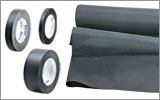

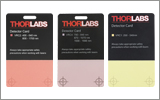

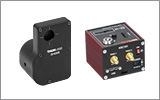
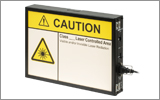
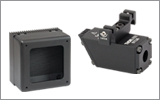

 Michelson Interferometer Kit
Michelson Interferometer Kit